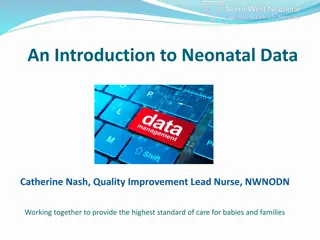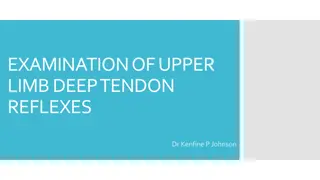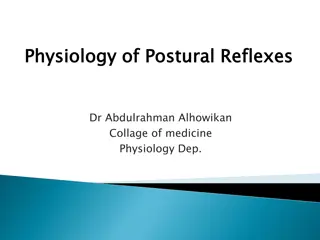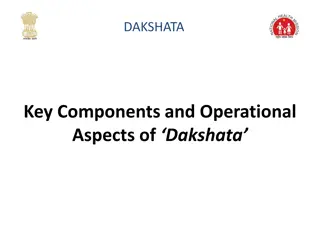Understanding Neonatal Reflexes in Newborn Babies
Newborn babies exhibit a range of primitive reflexes, including the Moro reflex, Glabellar Tap, Rooting and Sucking reflex, Tonic Neck reflex, Palmar and Plantar grasp reflexes. These reflexes serve as indicators for neurological development and function. Observing the presence and characteristics of these reflexes can offer valuable clinical insights into the baby's health and potential future issues.
Download Presentation

Please find below an Image/Link to download the presentation.
The content on the website is provided AS IS for your information and personal use only. It may not be sold, licensed, or shared on other websites without obtaining consent from the author. Download presentation by click this link. If you encounter any issues during the download, it is possible that the publisher has removed the file from their server.
E N D
Presentation Transcript
NEONATAL REFLEXS NEONATAL REFLEXS PRESENTED BY PRESENTED BY - - DR KRITIKA JOSHI ASSISTANT PROFESSOR KAUMARBHRITYA Dept. HAMC & H
Neontal Reflexes The newborn babies have a large number of primitive reflexes which are brain- stem mediated automatic responses. These reflexes are useful for clinical purposes. One should observe whether the response is sluggish , normal, exaggerated and symmetric or asymmetric.
1. Moro Reflex or Startle Reflex 2.Glabellar Tap 3.Rooting and Sucking Reflex 4.Tonic neck Reflex 5. Palmar Reflex 6. Plantar Reflex 7. Stepping Reflex
1. MORO REFLEX- The baby should be held supine over the right hand and arm, the flexed head is suddenly allowed todrop by about 30 angle . A positive response abduction and extension of upper limbs and opening of hands adduction and flexion. Moro response is asymmetric in brachial palsy and fracture of clavicle or humerus. consists of rapid followed by slower
2. Glabellar Tap Tapping of nasion is followed by closure of eyes in infants above 30 weeks gestation. 3.Rooting and Sucking reflex- Stimulation of angle of mouth or lips would initiate rooting and sucking in infants above 34 weeks gestation
4. Tonic neck reflex- When the baby's head is turned to one side , the ipsilateral arm and leg gets extended while contralateral limbs are flexed . If a baby constantly or persistently maintains, the tonic neck posture , it is abnormal and may signify future development of cerebral palsy .
5 & 6 Palmar and plantar grasp- The finger is placed on the palmar surface of fingers or plantar surface of toes of the baby to elicit grasp or flexion of toes . Most primitive reflexes' disappear b/w 3 and 4 months of age and their persistence is considered as an early sign of cerebral palsy.
7. Stepping Reflex - Consists of movements of walking which are elicited when the infant is held upright and inclined forward with soles of feet touching a flat surface .
REFLEX PRESENT DISAPPEAR MORO REFLEX FROM BIRTH AFTER 3 MONTH STEPPING REFLEX FROM BIRTH AFTER 6 WEEKS SUCKING REFLEX FROM BIRTH AFTER 4 MONTH PALMAR REFLEX FROM BIRTH AFTER 6 MONTH PLANTAR REFLEX FROM BIRTH AFTER 10 MONTH TONIC NECK REFLEX FROM BIRTH AFTER 4 MONTHS























